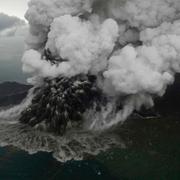
Sista javanoshörningarna klarade sig undan tsunamin
Världens sista javanoshörningar överlevde tsunamin i Indonesien. Trots att flodvågen slog in över sydvästra Java, där noshörningarna håller till, klarade sig djuren undan oskadda, skriver TT.
Arten är en av jordens mest sällsynta med sina 67 individer. Alla lever i nationalparken Ujung Kulon på Javas västspets. Tsunamin träffade södra delen, medan noshörningarna lever i den norra.
Tsunamin drabbade nationalparken kort efter utbrottet. Två personer ska ha dödats där och ett stort antal båtar och byggnader förstördes.
bakgrund
Javanoshörningen
Wikipedia (en)
The Javan rhinoceros (Rhinoceros sondaicus), also known as the Sunda rhinoceros or lesser one-horned rhinoceros, is a very rare member of the family Rhinocerotidae and one of five extant rhinoceroses. It belongs to the same genus as the Indian rhinoceros, and has similar mosaic, armour-like skin, but at 3.1–3.2 m (10–10 ft) in length and 1.4–1.7 m (4.6–5.6 ft) in height, it is smaller (closer in size to the black rhinoceros of the genus Diceros). Its horn is usually shorter than 25 cm (9.8 in), and is smaller than those of the other rhino species. Only adult males have horns; females lack them altogether.
Once the most widespread of Asian rhinoceroses, the Javan rhinoceros ranged from the islands of Java and Sumatra, throughout Southeast Asia, and into India and China. The species is critically endangered, with only one known population in the wild, and no individuals in captivity. It is possibly the rarest large mammal on Earth, with a population of as few as 58 to 61 in Ujung Kulon National Park at the western tip of Java in Indonesia. A second population in Cat Tien National Park in Vietnam was declared by some conservation groups to be extinct in 2011. The decline of the Javan rhinoceros is attributed to poaching, primarily for their horns, which are highly valued in traditional Chinese medicine, fetching as much as US$30,000 per kg on the black market. As European presence in their range increased, trophy hunting also became a serious threat. Loss of habitat, especially as the result of wars, such as the Vietnam War, in Southeast Asia, has also contributed to the species' decline and hindered recovery. The remaining range is within one nationally protected area, but the rhinos are still at risk from poachers, disease, and loss of genetic diversity leading to inbreeding depression.
The Javan rhino can live around 30–45 years in the wild. It historically inhabited lowland rain forest, wet grasslands, and large floodplains. It is mostly solitary, except for courtship and offspring-rearing, though groups may occasionally congregate near wallows and salt licks. Aside from humans, adults have no predators in their range. The Javan rhino usually avoids humans. Scientists and conservationists rarely study the animals directly due to their extreme rarity and the danger of interfering with such an endangered species. Researchers rely on camera traps and fecal samples to gauge health and behavior. Consequently, the Javan rhino is the least studied of all rhino species. Two adult rhinos with their calves were filmed in a motion-triggered video released on February 28, 2011, by WWF and Indonesia's National Park Authority, which proved it is still breeding in the wild. In April 2012, the National Parks Authority released video showing 35 individual Javan rhinos, including mother/offspring pairs and courting adults. There are only 58 to 68 individuals left in the wild, and none in captivity, after the death of a male rhinoceros named Samson. Samson died in April 2018 at 30 years of age, far younger than the species' usual lifespan of 50 to 60 years, so DNA test is being conducted to explore the cause of death, including the possibility of inbreeding degeneration.
Mer om tsunamin
Omni är politiskt obundna och oberoende. Vi strävar efter att ge fler perspektiv på nyheterna. Har du frågor eller synpunkter kring vår rapportering? Kontakta redaktionen


